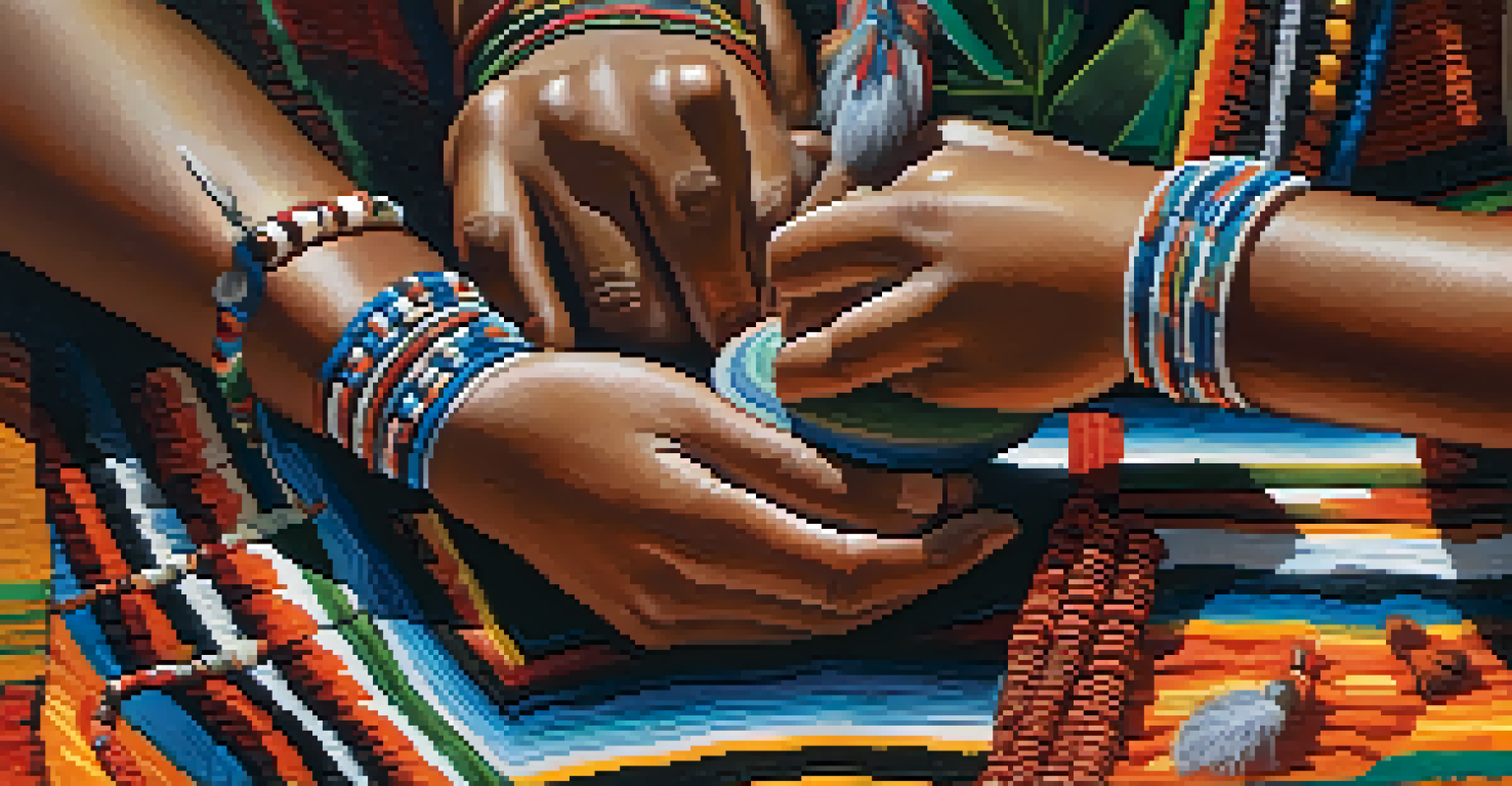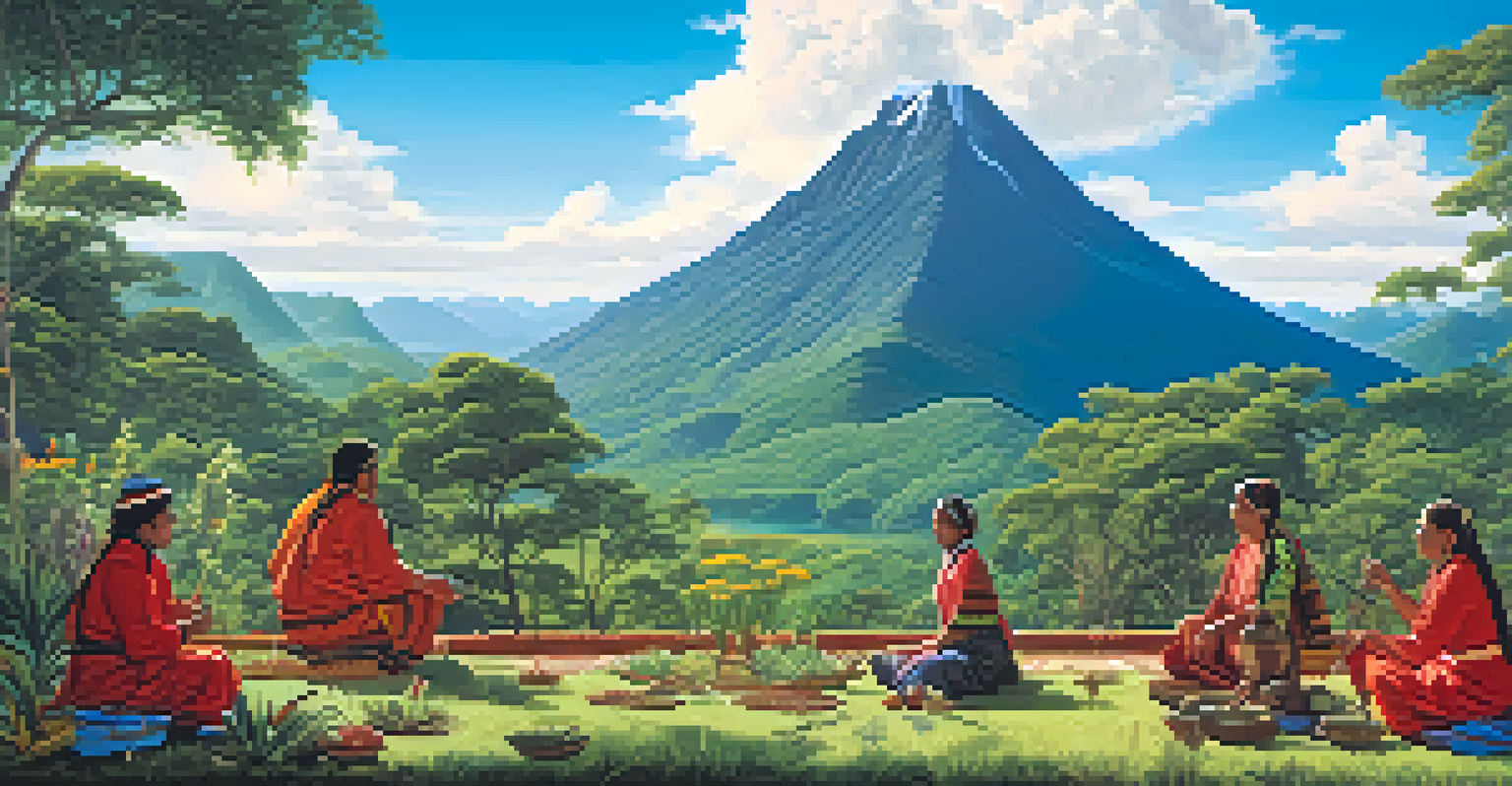Indigenous Spirituality: Beliefs Through Generations

Understanding Indigenous Spirituality and Its Roots
Indigenous spirituality encompasses a rich tapestry of beliefs and practices that connect communities to their ancestors, land, and the cosmos. Unlike organized religions that often have a single doctrine, Indigenous spirituality varies widely among different cultures, each with its unique traditions and stories. This deep connection to nature and the universe is a cornerstone of their beliefs, reflecting a worldview where everything is interrelated.
We do not inherit the earth from our ancestors, we borrow it from our children.
Central to many Indigenous beliefs is the idea of a living universe, where animals, plants, and even inanimate objects possess a spirit. This perspective fosters a profound respect for the environment, as nature is seen not just as a resource but as a relative. For instance, many tribes perform rituals to honor the spirits of animals before hunting, illustrating their commitment to balance and reciprocity with nature.
As generations pass, these spiritual beliefs are transmitted through oral traditions, ceremonies, and community practices. Elders play a crucial role in this transmission, guiding younger members in understanding their cultural heritage. This ongoing, dynamic process ensures that while practices may evolve, their core values remain deeply rooted in respect and interconnectedness.
The Role of Ancestors in Indigenous Spirituality
In Indigenous cultures, ancestors are revered and play a pivotal role in spiritual beliefs. They are seen as guides, protectors, and sources of wisdom, reminding the community of their history and traditions. This connection to ancestors reinforces a sense of identity and belonging, as individuals recognize that they are part of a larger collective.

Rituals such as commemorative ceremonies and storytelling are common ways to honor ancestors. These practices not only celebrate their lives but also reinforce the values and lessons they imparted. For example, during a potlatch, a type of ceremony among some Indigenous peoples of the Pacific Northwest, stories of ancestors are shared, emphasizing their contributions to the community's identity.
Connection to Ancestors is Vital
Indigenous spirituality emphasizes the crucial role of ancestors as guides and sources of wisdom, fostering a strong sense of identity and belonging.
Moreover, the belief in ancestral spirits often extends to a sense of responsibility. Individuals are encouraged to live in a way that honors their ancestors’ sacrifices and teachings. This sense of duty fosters a continuous dialogue between past, present, and future generations, ensuring that cultural values are upheld.
Ceremonies: A Living Expression of Beliefs
Ceremonies are vital expressions of Indigenous spirituality, serving as both spiritual and communal activities. They mark important life events, seasonal changes, and significant milestones, fostering a sense of unity among participants. From powwows to sweat lodges, each ceremony is steeped in meaning and tradition, often involving songs, dances, and offerings.
The land is sacred. It is the earth that supports us and nourishes us.
These gatherings not only celebrate cultural heritage but also reinforce spiritual connections. For instance, during a vision quest, individuals seek spiritual guidance and clarity, often spending time in nature to connect with the divine. This practice emphasizes introspection and personal growth, allowing participants to emerge with newfound insights.
Ceremonies also serve as educational platforms, where younger generations learn about their cultural heritage. Elders share stories and teachings, ensuring that the community's history and beliefs are preserved. This blend of celebration and education cultivates a living tradition that evolves while maintaining its core essence.
Nature's Significance in Indigenous Spiritual Practices
Nature holds a sacred place in Indigenous spirituality, often viewed as a source of life and wisdom. Mountains, rivers, and forests are not merely backdrops but integral elements of spiritual narratives. This relationship encourages a profound respect for the environment, where every element is seen as interconnected and deserving of reverence.
For many Indigenous communities, land is more than just property; it is a living entity with which they share a reciprocal relationship. Practices like sustainable hunting and gathering illustrate this philosophy, with the understanding that taking from nature comes with an obligation to protect and preserve. This symbiotic relationship showcases a commitment to stewardship that has been passed down through generations.
Nature is Sacred and Interconnected
Nature is viewed as a living entity, with Indigenous practices reflecting a deep respect for the environment and a commitment to stewardship.
Seasonal changes are also marked by spiritual practices, with rituals often aligned with the cycles of nature. For example, planting and harvesting ceremonies celebrate the Earth’s gifts, reinforcing gratitude and respect. These practices highlight the deep-rooted belief that humans are custodians of the land, tasked with maintaining its health for future generations.
Oral Traditions: The Heartbeat of Indigenous Wisdom
Oral traditions are the heartbeat of Indigenous spirituality, serving as the primary means of transmitting culture and beliefs. Through storytelling, songs, and chants, generations share knowledge, history, and spiritual teachings. This method not only preserves the intricate details of their beliefs but also keeps them alive and relevant in a changing world.
Stories often contain moral lessons and insights into the relationship between humans and the natural world. For example, tales of trickster figures illustrate the complexities of human behavior and the importance of humility and respect. These narratives serve as both entertainment and education, fostering a deep understanding of cultural values.
Moreover, oral traditions adapt over time, allowing for new interpretations and relevance. As communities face modern challenges, these stories can be reframed to address contemporary issues while maintaining their core messages. This adaptability ensures that Indigenous spirituality continues to resonate with younger generations, keeping their heritage vibrant and alive.
Modern Challenges Facing Indigenous Spirituality
Indigenous spirituality faces numerous challenges in today's rapidly changing world. Colonization, globalization, and environmental degradation have put immense pressure on these traditions, often leading to loss of land, culture, and language. As a result, many Indigenous communities struggle to maintain their spiritual practices in the face of modernity.
Additionally, the appropriation of Indigenous spirituality by non-Indigenous individuals can dilute its meaning and significance. Practices that were once sacred may be commercialized or misrepresented, leading to a disconnect between the original cultural context and contemporary interpretations. This phenomenon raises concerns about respect and authenticity in spiritual practices.
Oral Traditions Preserve Culture
Oral traditions serve as the heartbeat of Indigenous spirituality, transmitting knowledge and values through storytelling and adapting to contemporary challenges.
Despite these challenges, many Indigenous communities are actively working to revitalize their spirituality. Initiatives to reclaim traditional practices, languages, and lands are becoming more common. By fostering a sense of pride and identity, these efforts not only preserve cultural heritage but also strengthen the resilience of Indigenous spirituality in a modern context.
The Future of Indigenous Spirituality: Hope and Resilience
The future of Indigenous spirituality holds both hope and resilience as communities adapt to the modern world. Younger generations are increasingly engaging with their cultural heritage, seeking to understand and incorporate traditional beliefs into their lives. This revitalization is often fueled by a desire to reconnect with their roots and embrace their identity.
Collaborative efforts between Indigenous and non-Indigenous peoples are also emerging, aimed at mutual understanding and respect. Education about Indigenous spirituality in schools and community programs can foster appreciation and awareness among broader audiences. Such initiatives encourage dialogue and dismantle stereotypes, paving the way for a more inclusive society.

Ultimately, the enduring nature of Indigenous spirituality shines through its ability to adapt while remaining grounded in tradition. As communities continue to navigate modern challenges, their spiritual practices will likely evolve, ensuring that the wisdom of ancestors and the interconnectedness of life remain central to their identity for generations to come.